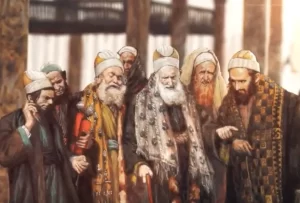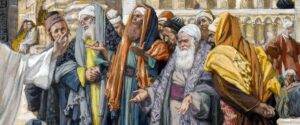Archenemies of Jesus – the Best Witnesses
Archenemies of Jesus of Nazareth, Jewish leaders, are some of the best witnesses to his birth, life, crucifixion and resurrection. Typically cited by the Gospels in a negative context, they inadvertently acknowledged that Jesus performed miracles and did things foretold in the prophecies.

One prophetic requirement generally undisputed by Judaism is the Messiah must be born in the lineage of King David. Branch prophecies by Isaiah, Jeremiah and Zachariah are among such prophecies, further concurred by some Rabbi sages.[1]
Mary about to give birth in Nazareth, was compelled by the decree of Caesar Augustus to make the 90-mile trip to Bethlehem because she was in the lineage of King David. Along with her husband, Joseph, who was also in the lineage of David, together the couple traveled to Bethlehem at the behest of the decree.[2]
According to Jewish Law, a month after the birth of a first-born son, the baby was to be redeemed in a ceremony managed by a priest known as the Redemption of the First-born. Luke’s account states that Joseph and Mary took baby Jesus to the Temple for this purpose.[3]
One main purpose of the Redemption of the First-born was to affirm the son’s right of inheritance. Customary practice was for the father to pronounce a blessing on his son followed by a feast where a Jewish priest had a dialog with the father to make an impression upon the attendees.[4]
All four Gospels contain accounts of Jewish religious leaders wanting retribution when Jesus performed miracles on a Sabbath. To level the accusations, the Jewish leadership first had to acknowledge miracles had occurred in order to criticize the activities of Jesus.
One Sabbath, Jesus healed a man with a withered hand in a synagogue, a place of prayer and worship headed by a Rabbi.[5] Pharisees didn’t like that he had performed a miracle on a Sabbath and reacted by plotting against Jesus.[6]
In a synagogue on a Sabbath, Jesus saw a woman who had not been able to straighten up for 18 years.[7] When Jesus instantly healed her infirmity, the leader of the synagogue and other critics became indignant along with their rejoicing humiliated the Pharisees compelling them to take no action.[8]
Near the Sheep’s Gate at the Pool of Bethesda on a Sabbath, Jesus saw a man who had been disabled for 38 years. Jesus simply commanded the man to get up, grab his mat, and walk away which the man did immediately.
Jewish leaders accused the healed man of carrying his mat on a Sabbath in violation of the Law. The man pointed out that the person who healed him told him to do it and Jewish leaders turned their focus to Jesus accusing him of working on the Sabbath.[9]
On another Sabbath, Jesus noticed a man who had been blind since birth stopping to talk to him. Jesus smeared mud on the man’s eyes and had him wash it off in the pool of Siloam making the man to see for the first time in his life.
Doggedly the Pharisees questioned the man, then his parents who confirmed his blindness since birth. Questioning the healed man again who answered he had already answered their questions; nevertheless Pharisees heaped insults on the man.
JN 9:30-33 “Why, this is a marvelous thing, that you do not know where He is from; yet He has opened my eyes! We know that God does not hear sinners; but if anyone is God-fearing and does His will, He hears him. Since the beginning of time it has never been heard that anyone opened the eyes of a person born blind. If this man were not from God, He could do nothing.”NASB
Now infuriated, the Pharisees accused the formerly blind man of being a sinner who had no place to lecture them. Upset, the Pharisees threw him out of the place where they were questioning him.[10]
Jairus, a synagogue leader, begged Jesus to heal his 12-year old daughter who was dying. Before Jesus could reach his house, friends arrived with news that the daughter of Jairus had died, but Jesus still went to his house encountering people who were loudly crying and wailing.
Asking everyone to leave excepting Jairus, his wife and some followers, Jesus went into the room and said, “Talitha koum,” get up and walk. The girl immediately stood up and walked around the room astonishing those who were present.11]
Bethany was the town where Lazarus lived, died and was buried. Arriving four days after Lazarus died, Jesus raised him from the tomb where he was laid to rest.[12]
Pharisees heard about the miracle fearing the Romans if the people followed Jesus called a council meeting with the chief priests to devise a plan to deal with Jesus. High Priest Caiaphas was at the meeting and proposed that only one man should be killed for the entire nation prompting them to make plans accordingly.[13]
Judaism agrees with the Gospels in that Jesus was executed by crucifixion.[14] In opposition to Christianity, Judaism asserts the method of crucifixion is the reason why Jesus could not be the Messiah:[15]
“The very form of his punishment would disprove those claims in Jewish eyes. No Messiah that Jews could recognize could suffer such a death…” (Deut. xxi. 23), ‘an insult to God’ (Targum, Rashi).” – JewishEnclopedia.com
After the crucifixion of Jesus, Chief priests and the Pharisees approached Rome’s jurisdictional authority of Judea acknowledging Jesus was dead and buried in a tomb requesting Pilate, to secure the tomb to prevent the body from being stolen.[16] As a consequence, the tomb was sealed and guarded by a Roman-Jewish contingent called a koustodia
According to Matthew, the Jewish Council responded to the report by some of the koustodia who said the tomb security was breached and was now empty. Some guards were worried about being punished for dereliction of duty; however, the Jewish Council paid them money promising to take care of Pilate if it became an issue.[17]
Do the acknowledgments by various Jewish leaders to the birth, life, crucifixion and resurrection support the Gospels accounts?
Updated April 13 , 2025.
This work is licensed under a Creative Commons Attribution-NonCommercial-NoDerivatives 4.0 International License.
REFERENCES:
[1] Isaiah 11:1-2; Jerimiah 23:5, 33:15, Zechariah 3.8, 6:12-13. Maimonides, “Letter to the South (Yemen)”. p374. Neubauer, Adolf, and Driver, Samuel Rolles. The Fifty-third Chapter of Isaiah According to the Jewish Interpreters. <https://books.google.com/books?id=YxdbAAAAQAAJ&pg=PP1&hl=en#v=onepage&q=advent&f=false> Crispin, Moshe Kohen ibn. “Sefer ha-Musar.” Neubauer, Driver, et. al. The Fifty-third Chapter of Isaiah According to the Jewish Interpreters. pp 99-101. Marlowe, Michael. Editions of the Hebrew Text of the Bible. Bible Research. “The Incunabula.” 2012. <http://www.bible-researcher.com/hebrew-editions.html> Rosenau, William. Jewish Biblical Commentators. pp 87-91 n.d. <http://www.archive.org/stream/jewishbiblicalco00rose/jewishbiblicalco00rose_djvu.txt> The fifty-third chapter of Isaiah According to the Jewish Interpreters. pp 99-100. Niles, Randall. DrivethruHistory.com. “Caiaphas the High Priest.” 2017. Image. https://i0.wp.com/www.drivethruhistory.com/wp-content/uploads/2017/04/caiphas-the-high-priest.png?ssl=1> Last accessed 23 Mar. 2023.
[2] Nehemiah 12:23. Josephus, Flavius. The Life of Flavius Josephus. Trans. and Commentary. William Whitson. The Complete Works of Josephus. #1, footnote t. n.d. <http://books.google.com/books?id=e0dAAAAAMAAJ&printsec=frontcover&source=gbs_ge_summary_r&cad=0#v=onepage&q&f=false> Maimon, Moshe ben (Maimonides). “Melachim uMilchamot.” Chabad.org. Chapter 11, #4. <https://www.chabad.org/library/article_cdo/aid/1188356/jewish/Melachim-uMilchamot-Chapter-11.htm> Soncino Babylonian Talmud. Ed. Isidore Epstein based on the Wilna Romm Edition. Sanhedrin Chapter VI, Folio 43a. 1935-1948. <https://israelect.com/Come-and-Hear/talmud/index.html> Shachter, J. and Freedman, H. “Sanhedrin.” Soncino Babylonian Talmud. “Introduction.” Greenberg, Eric J. “Jesus’ Death Now Debated by Jews.” Jewish Journal. 2003. Reprinted from The Jewish Week. <http://jewishjournal.com/news/world/8546>
[3] Luke 2:22-24.
[4] Exodus 18:25-26; Deuteronomy 1:15-17, 16:18-20; Leviticus 12:6-7; Numbers 18:15-16; Matthew 12:9; Mark 11:18; Luke 6:6-11; John 11:46-48. CR Exodus 13:2; Numbers 3:46-49, Deuteronomy 21:17. Edersheim, Alfred. The Temple – Its Ministry and Service. 1826 -1889. “The Offering for the First-born.” <https://www.ccel.org/ccel/edersheim/temple/temple.xx.html#fna_xx-p4.1> “First-born, Redemption of.” Jewish Encyclopedia. <https://jewishencyclopedia.com/articles/6138-first-born-redemption-of> “First Born, Redemption of.” Jewish Encyclopedia. 2011. Sanhedrin 49b. Soncino Babylonian Talmud. <https://israelect.com/Come-and-Hear/sanhedrin/sanhedrin_49.html> “Chief Priests.” Encyclopedia.com. 2019. <https://www.encyclopedia.com/religion/encyclopedias-almanacs-transcripts-and-maps/chief-priests>
[5] John 12:42-43. “What Is a Synagogue?” Chabad.org. n.d. <https://www.chabad.org/library/article_cdo/aid/365930/jewish/What-Is-a-Synagogue.htm>
[6] Matthew 12:9-14; Mark 3:1-6; Luke 6:6-11.
[7] “Kyphosis.” Mayo Clinic. n.d. <https://www.mayoclinic.org/diseases-conditions/kyphosis/symptoms-causes/syc-20374205> “What Causes a Hunchback (Kyphosis)? Symptoms, Diagnosis, and Treatment Tips.” Doctors Health Press. 2017. < https://www.doctorshealthpress.com/causes-symptoms-hunchback-kyphosis-treatment-tips/>
[8] Luke 13:10-17.
[9] John 5:3-18.
[10] John 9:1-34.
[11] Mark 5:21-43.
[12] John 11:38-44.
[13] John 11:46-53.
[14] Melachim uMilchamot.” Chabad.org. n.d. Chapter 11.4.
[15] Tacitus, Gaius Cornelius. The Annals. 109 AD. Trans. Alfred John Church and William Jackson Brodribb. Internet Classic Archive. 2009. Book XV. <http://classics.mit.edu/Tacitus/annals.html> Suetonius (C. Suetonius Tranquillus or C. Tranquillus Suetonius). The Lives of the Twelve Caesars. Book VI “Nero.” #16. University of Chicago|Bill Thayer. <http://penelope.uchicago.edu/Thayer/E/Roman/Texts/Suetonius/12Caesars/home.html> Lucian of Samosata. “The Death of Peregrine.” The Works of Lucian of Samosata. Volume IV. <http://www.sacred-texts.com/cla/luc/wl4/wAXl420.htm> “Jesus of Nazareth.” Jewish Encyclopedia. 2011. <http://www.jewishencyclopedia.com/articles/8616-jesus-of-nazareth> “God Cannot die!” TorahOfMessiah.com. 2012. <https://web.archive.org/web/20140331233206/http://www.torahofmessiah.com/godcantdie.html> Soncino Babylonian Talmud. Ed. Epstein, Isidor. “Introduction to the Seder Nezikin.” Sanhedrin Chapter VI, Folio 43a. Shachter & Freedman. “Introduction to Sanhedrin.” Soncino Babylonian Talmud. Greenberg, Eric J. “Jesus’ Death Now Debated by Jews.” Jewish Journal. 2003. Reprinted from The Jewish Week. <http://jewishjournal.com/news/world/8546>
[16] Matthew 27:57, Mark 15:43, Luke 23:50-52, John 19:38. Mark 15:43. Net.Bible.org. Footnote #1. <http://classic.net.bible.org/verse.php?book=Mar&chapter=15&verse=43#> Luke 23:50. Net.Bible.org. Footnote #2. <http://classic.net.bible.org/verse.php?book=Luk&chapter=23&verse=50>
[17] Matthew 28: 11-15.


